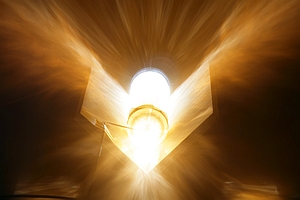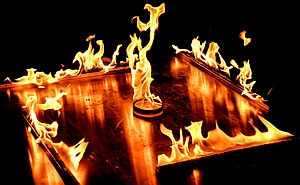
“An open-shutter image of detonation in a tube of Ammonium Nitrate and Fuel Oil (ANFO) captures a bird-like shape emerging from the product ashes. This image was captured with a Canon EOS-1Ds Mark II running at ISO 100, in bulb mode, with a 200mm focal length lens at f/22.”
Scott I. Jackson (Los Alamos National Laboratory)

“Fire whirls can form under a variety of different flow conditions. One common flow condition that results in their formation is the presence of multiple line fires, which cause buoyant plumes (walls) to surround a central pseudo enclosure. The low pressure in this region is conducive to the entrainment of swirling flow, resulting in the formation of a fire whirl. This image shows a laboratory study of this configuration, formed using a fuel pool 10 cm in diameter, surrounded by four line fires, all with n-heptane. This image was captured using a Nikon D500 at f/14 with an exposure time of 1/800 s. The authors thank the Bureau of Safety and Environmental Enforcement (140E0121C0004) for supporting this work.”
Sriram Bharath Hariharan, Joseph L. Dowling, Michael J. Gollner (University of California, Berkeley)